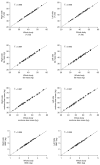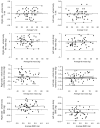Body composition measured by dual-energy X-ray absorptiometry half-body scans in obese adults
- PMID: 19584885
- PMCID: PMC2709755
- DOI: 10.1038/oby.2009.14
Body composition measured by dual-energy X-ray absorptiometry half-body scans in obese adults
Abstract
Dual-energy X-ray absorptiometry (DXA) has become a common measurement of human body composition. However, obese subjects have been understudied largely due to weight and scan area restrictions. Newer DXA instruments allow for heavier subjects to be supported by the DXA scanner, but the imaging area is still smaller than the body size of some obese subjects. In this study, we determined the validity of an automated half-scan methodology by comparing to the standard whole-body scans in a cohort of obese volunteers. Fifty-two subjects whose BMI>30 kg/m2 completed whole-body iDXA (GE Lunar) scans. The resulting scans were analyzed in three ways: the standard whole-body scan, total body estimated from the left side, and from the right side. Fat mass, nonbone lean mass, bone mineral content (BMC), and percent fat derived from each half scan were compared to the whole-body scans. Total fat mass, nonbone lean mass, or percent fat was comparable for the whole-body scans, left, and right side scans (>97% within individuals and >99.9% for the group). The BMC estimate using the right side scan was slightly but statistically higher than the whole-body BMC (approximately 30 g or 1%, P<0.001), while the left side scan BMC estimate was lower than the whole-body BMC by the same magnitude. No significant magnitude bias was found for any of the composition variables. We conclude that the new iDXA half-body analysis in obese subjects appears to be closely comparable to whole-body analysis for fat mass, nonbone lean mass, and percent fat.
Figures



References
-
- Ellis KJ. Human body composition: in vivo methods. Physiol Rev. 2000;80:649–680. - PubMed
-
- Goodsitt MM. Evaluation of a new set of calibration standards for the measurement of fat content via DPA and DXA. Med Phys. 1992;19:35–44. - PubMed
-
- Tataranni PA, Ravussin E. Use of dual-energy X-ray absorptiometry in obese individuals. Am J Clin Nutr. 1995;62:730–734. - PubMed
-
- Bland JM, Altman DG. Statistical methods for assessing agreement between two methods of clinical measurement. Lancet. 1986;1:307–310. - PubMed
Publication types
MeSH terms
Grants and funding
LinkOut - more resources
Full Text Sources
Medical

